初中英语五大动词时态
初中英语动词八大时态详解
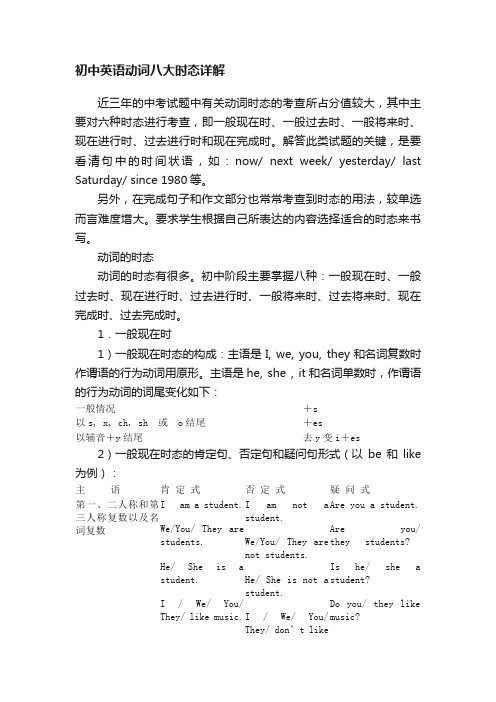
初中英语动词八大时态详解
近三年的中考试题中有关动词时态的考查所占分值较大,其中主要对六种时态进行考查,即一般现在时、一般过去时、一般将来时、现在进行时、过去进行时和现在完成时。解答此类试题的关键,是要看清句中的时间状语,如:now/ next week/ yesterday/ last Saturday/ since 1980等。
另外,在完成句子和作文部分也常常考查到时态的用法,较单选而言难度增大。要求学生根据自己所表达的内容选择适合的时态来书写。
动词的时态
动词的时态有很多。初中阶段主要掌握八种:一般现在时、一般过去时、现在进行时、过去进行时、一般将来时、过去将来时、现在完成时、过去完成时。
1.一般现在时
1)一般现在时态的构成:主语是I, we, you, they和名词复数时作谓语的行为动词用原形。主语是he, she , it和名词单数时,作谓语的行为动词的词尾变化如下:
一般情况+s
以s, x, ch, sh 或o结尾+es
以辅音+y结尾去y变i+es 2)一般现在时态的肯定句、否定句和疑问句形式(以be和like 为例):
主语肯定式否定式疑问式
第一、二人称和第三人称复数以及名词复数I am a student.
We/You/ They are
students.
He/ She is a
student.
I / We/ You/
They/ like music.
I am not a
student.
We/You/ They are
not students.
He/ She is not a
初中英语动词八大时态知识点归纳
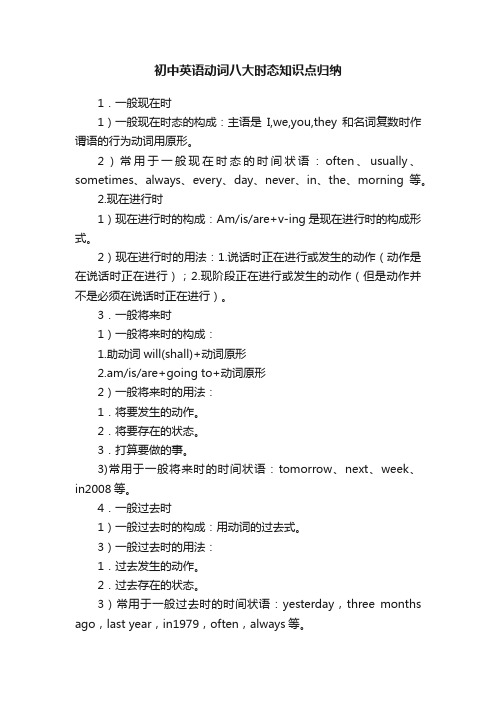
初中英语动词八大时态知识点归纳
1.一般现在时
1)一般现在时态的构成:主语是I,we,you,they和名词复数时作谓语的行为动词用原形。
2)常用于一般现在时态的时间状语:often、usually、sometimes、always、every、day、never、in、the、morning等。
2.现在进行时
1)现在进行时的构成:Am/is/are+v-ing是现在进行时的构成形式。
2)现在进行时的用法:1.说话时正在进行或发生的动作(动作是在说话时正在进行);2.现阶段正在进行或发生的动作(但是动作并不是必须在说话时正在进行)。
3.一般将来时
1)一般将来时的构成:
1.助动词will(shall)+动词原形
2.am/is/are+going to+动词原形
2)一般将来时的用法:
1.将要发生的动作。
2.将要存在的状态。
3.打算要做的事。
3)常用于一般将来时的时间状语:tomorrow、next、week、in2008等。
4.一般过去时
1)一般过去时的构成:用动词的过去式。
3)一般过去时的用法:
1.过去发生的动作。
2.过去存在的状态。
3)常用于一般过去时的时间状语:yesterday,three months ago,last year,in1979,often,always等。
5.现在完成时
1)现在完成时的构成:have/has+v-ed
2)现在完成时的用法:
1、表示过去发生的动作对现在造成的影响或结果.常与already,just,ever,never,before等词连用.
2、表示“过去的动作”一直延续到现在并有可能继续延续下去.常与for(后跟段时间)或since(后跟点时间)等连用.
初中英语动词时态及语态
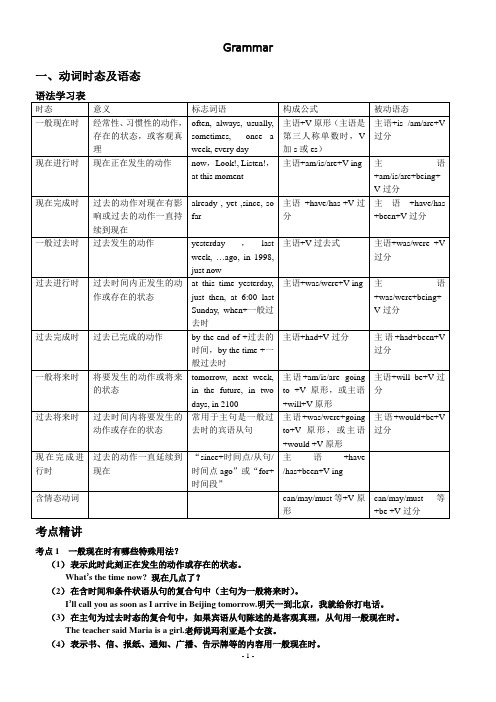
Grammar
一、动词时态及语态
语法学习表
时态意义标志词语构成公式被动语态
一般现在时经常性、习惯性的动作,
存在的状态,或客观真
理often, always, usually,
sometimes, once a
week, every day
主语+V原形(主语是
第三人称单数时,V
加s或es)
主语+is /am/are+V
过分
现在进行时现在正在发生的动作now,Look!, Listen!,
at this moment 主语+am/is/are+V-ing 主语
+am/is/are+being+
V过分
现在完成时过去的动作对现在有影
响或过去的动作一直持
续到现在already , yet ,since, so
far
主语+have/has +V过
分
主语+have/has
+been+V过分
一般过去时过去发生的动作yesterday ,last
week, …ago, in 1998,
just now 主语+V过去式主语+was/were +V
过分
过去进行时过去时间内正发生的动
作或存在的状态at this time yesterday,
just then, at 6:00 last
Sunday, when+一般过
去时
主语+was/were+V-ing 主语
+was/were+being+
V过分
过去完成时过去已完成的动作by the end of +过去的
时间,by the time +一
般过去时主语+had+V过分主语+had+been+V
过分
一般将来时将要发生的动作或将来
的状态tomorrow, next week,
初中英语八大常用时态总结
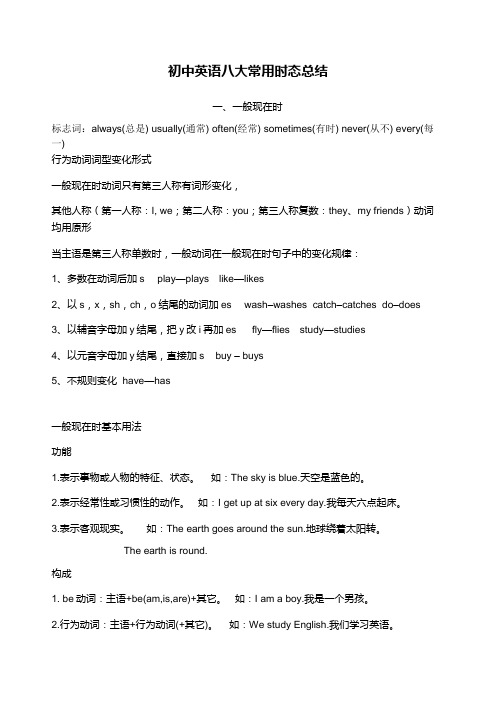
初中英语八大常用时态总结
一、一般现在时
标志词:always(总是) usually(通常) often(经常) sometimes(有时) never(从不) every(每一)
行为动词词型变化形式
一般现在时动词只有第三人称有词形变化,
其他人称(第一人称:I, we;第二人称:you;第三人称复数:they、my friends)动词均用原形
当主语是第三人称单数时,一般动词在一般现在时句子中的变化规律:
1、多数在动词后加s play—plays like—likes
2、以s,x,sh,ch,o结尾的动词加es wash–washes catch–catches do–does
3、以辅音字母加y结尾,把y改i再加es fly—flies study—studies
4、以元音字母加y结尾,直接加s buy – buys
5、不规则变化 have—has
一般现在时基本用法
功能
1.表示事物或人物的特征、状态。如:The sky is blue.天空是蓝色的。
2.表示经常性或习惯性的动作。如:I get up at six every day.我每天六点起床。
3.表示客观现实。如:The earth goes around the sun.地球绕着太阳转。
The earth is round.
构成
1. be动词:主语+be(am,is,are)+其它。如:I am a boy.我是一个男孩。
2.行为动词:主语+行为动词(+其它)。如:We study English.我们学习英语。
句型
肯定句:A.be动词:主语+ be + 其它成分 He is a worker.
初中英语动词的时态
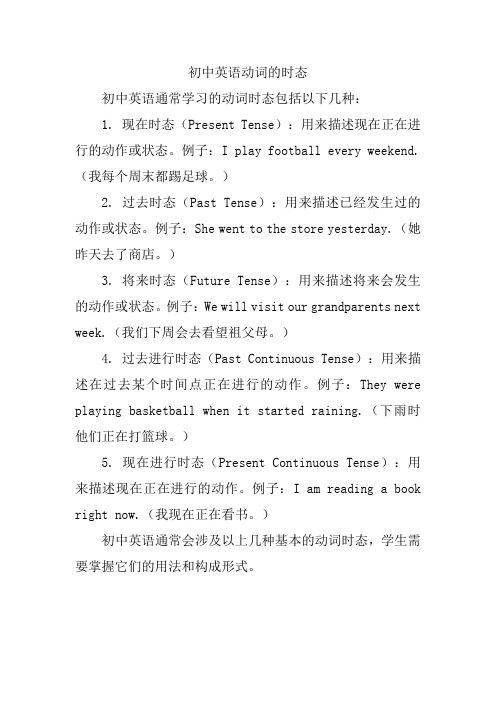
初中英语动词的时态
初中英语通常学习的动词时态包括以下几种:
1. 现在时态(Present Tense):用来描述现在正在进行的动作或状态。例子:I play football every weekend.(我每个周末都踢足球。)
2. 过去时态(Past Tense):用来描述已经发生过的动作或状态。例子:She went to the store yesterday.(她昨天去了商店。)
3. 将来时态(Future Tense):用来描述将来会发生的动作或状态。例子:We will visit our grandparents next week.(我们下周会去看望祖父母。)
4. 过去进行时态(Past Continuous Tense):用来描述在过去某个时间点正在进行的动作。例子:They were playing basketball when it started raining.(下雨时他们正在打篮球。)
5. 现在进行时态(Present Continuous Tense):用来描述现在正在进行的动作。例子:I am reading a book right now.(我现在正在看书。)
初中英语通常会涉及以上几种基本的动词时态,学生需要掌握它们的用法和构成形式。
初中英语时态讲解及练习
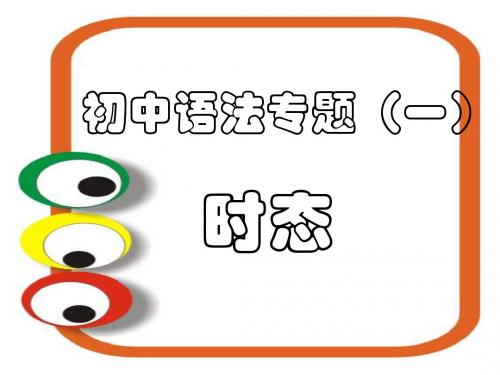
1.I ____(write, am writing, is writing, are writing) a letter now. 2.Look, it _____(begin, is beginning, am beginning, are beginning) to rain. 3.They ____(study, is studying, am studying, are studying) medicine at the Medical Institute of Chengde these days. 4.He _____(teach, am teaching, is teaching, are teaching) an English lesson at this time.
过去进行时常与过去某一特定时 间的状语连用,如 last night, at that time, at noon yesterday, last Sunday 等。 也有时没有时间状 语,要通过上下文的暗示来确定 用过去进行时。
1.I _____(cook, cooked, was cooking, were cooking) breakfast when you arrived. 2.What ____you_____( do, did, was...doing, were…doing) at this time yesterday evening? 3.We_____(have, are having, had, were having) dinner when the doorbell rang. 4.While/ When/ As we____( have, had, are having, were having) dinner, the doorbell rang.
初中英语 动词的时态(教案)
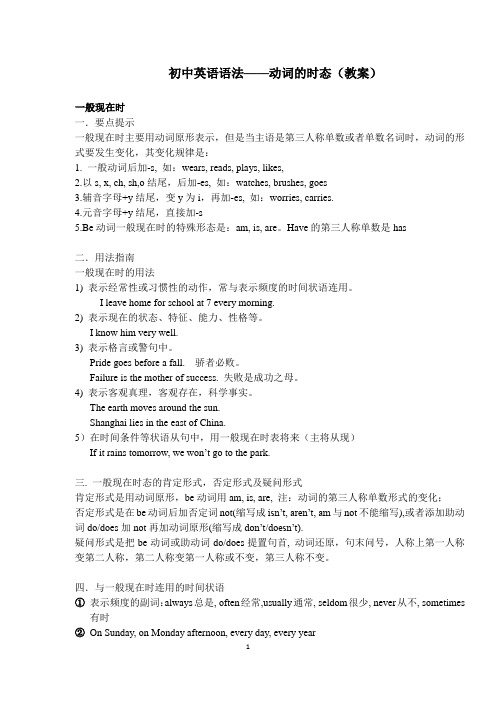
初中英语语法——动词的时态(教案)
一般现在时
一.要点提示
一般现在时主要用动词原形表示,但是当主语是第三人称单数或者单数名词时,动词的形式要发生变化,其变化规律是:
1. 一般动词后加-s, 如:wears, reads, plays, likes,
2.以s, x, ch, sh,o结尾,后加-es, 如:watches, brushes, goes
3.辅音字母+y结尾,变y为i,再加-es, 如:worries, carries.
4.元音字母+y结尾,直接加-s
5.Be动词一般现在时的特殊形态是:am, is, are。Have的第三人称单数是has
二.用法指南
一般现在时的用法
1) 表示经常性或习惯性的动作,常与表示频度的时间状语连用。
I leave home for school at 7 every morning.
2) 表示现在的状态、特征、能力、性格等。
I know him very well.
3) 表示格言或警句中。
Pride goes before a fall.骄者必败。
Failure is the mother of success. 失败是成功之母。
4) 表示客观真理,客观存在,科学事实。
The earth moves around the sun.
Shanghai lies in the east of China.
5)在时间条件等状语从句中,用一般现在时表将来(主将从现)
If it rains tomorrow, we won’t go to the park.
人教版初中英语时态复习课件
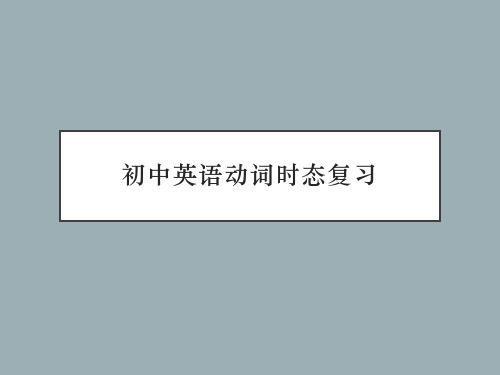
例句:I am working.
例句:I was working.
小结(Summary):
做动词时态题的时候要注意以下几个方面:
1.根据时间状语确定时态 2.根据上下文已有时态信息点确定时态 3.上下文语意确定时态 4.在复合句根据时态呼应确定时态 5.时态中的“特殊”对策
1. Neither of us ______ a doctor.
D. will put on
4._____ she _____ TV at seven yesterday evening ?
A. Was…watching B. Is…watch C. Has… watched D. Will…watch
.5.He can’t go to the cinema with me because he ____ a meeting.
例如:You are always changing your mind.
你老是改变主意。
2)表示渐变,这样的动词有:get, grow, become, turn, run, go, begin等。
例如 The leaves are turning red. 叶子在变红。
It's getting warmer and warmer.
B. don't do
C. didn’t do
初中英语动词时态

❖ 我妈妈现在在家。 do (like)
❖ 我喜欢画画。
do (plays)
❖ 他每天放学后和朋友踢足球。 do (help)
❖ 我们互相帮助。
英语句子三部曲
看见句子就问三个问题:
1.要用哪类动词做谓语?(主语干什么则考 虑实义动词do,主语怎么样了或者说是什么 就用系动词be) 2. 这个动作是谁发出的?人称是单数还是复 数? 3.这个动作啥时候发生的,用什么时态?
❖ I am a student.(是什么) 我是一个学生。
❖ The man is very tall and strong.(怎么样) 那男人又高又壮。
She is in the classroom. (在哪儿)
be动词的用法
与名词、数词、形容词、介词连用 1) I am a doctor. 2) He is ten. 3) They are tired. 4) The cat is under the table.
4. lie – lying 躺, die死 – dying, tie系 -tying
5. begin – beginning
❖我正在做蛋糕。
❖ I am making a cake.
❖他们正在跑。
❖ They are running.
❖他正在吃晚餐。
❖ He is having dinner. ❖ He is eating dinner.
英语初中时态总结

英语初中时态总结
英语初中时态总结如下:
一、一般现在时:表示现在的动作或状态。
肯定句:主语+动词原形/动词第三人称单数形式(用于第三人称单数主语)+其他。
例句:I love reading books.
He plays basketball every day.
否定句:主语+do/does(not)+动词原形+其他。
例句:I do not like watching TV.
He does not study Chinese.
疑问句:Do/does+主语+动词原形+其他?
例句:Do you play football on Saturdays?
Does he speak French?
二、一般过去时:表示过去已经完成的动作或事情。
肯定句:主语+动词过去时/动词不规则过去时/助动词+动词原形+其他。
例句:I went to the cinema last night.
He played basketball yesterday.
否定句:主语+did(not)+动词原形+其他。
例句:I did not like the movie.
He did not watch TV last night.
疑问句:Did+主语+动词原形+其他?
例句:Did you go to the party last night?
Did he play basketball yesterday?
三、现在进行时:表示现在正在进行或进行的动作。
肯定句:主语+be(am/is/are)+动词现在分词+其他。
例句:I am reading a book.
初中英语的动词时态主要有五种
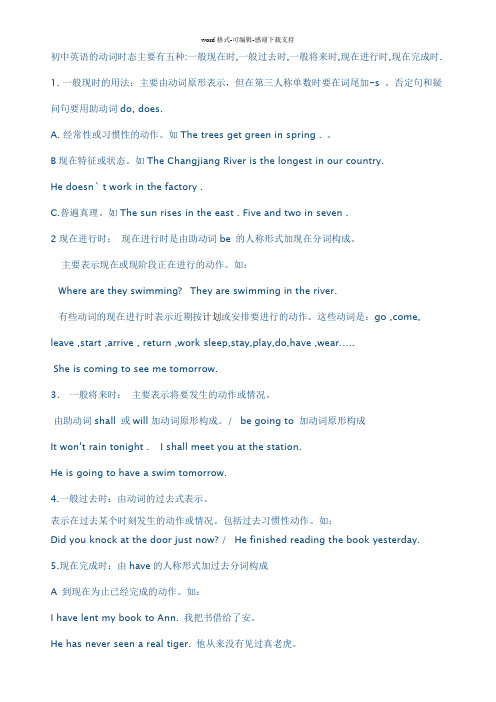
初中英语的动词时态主要有五种:一般现在时,一般过去时,一般将来时,现在进行时,现在完成时.
1. 一般现时的用法:主要由动词原形表示,但在第三人称单数时要在词尾加-s 。否定句和疑问句要用助动词do, does.
A. 经常性或习惯性的动作。如The trees get green in spring . 。
B现在特征或状态。如The Changjiang River is the longest in our country.
He doesn` t work in the factory .
C.普遍真理。如The sun rises in the east . Five and two in seven .
2现在进行时:现在进行时是由助动词be 的人称形式加现在分词构成。
主要表示现在或现阶段正在进行的动作。如:
Where are they swimming? They are swimming in the river.
有些动词的现在进行时表示近期按计划或安排要进行的动作。这些动词是:go ,come, leave ,start ,arrive , return ,work sleep,stay,play,do,have ,wear…..
She is coming to see me tomorrow.
3.一般将来时:主要表示将要发生的动作或情况。
由助动词shall 或will加动词原形构成。/ be going to 加动词原形构成
It won’t rain tonight .I shall meet you at the station.
初级中学英语动词时态归纳情况总结对照表
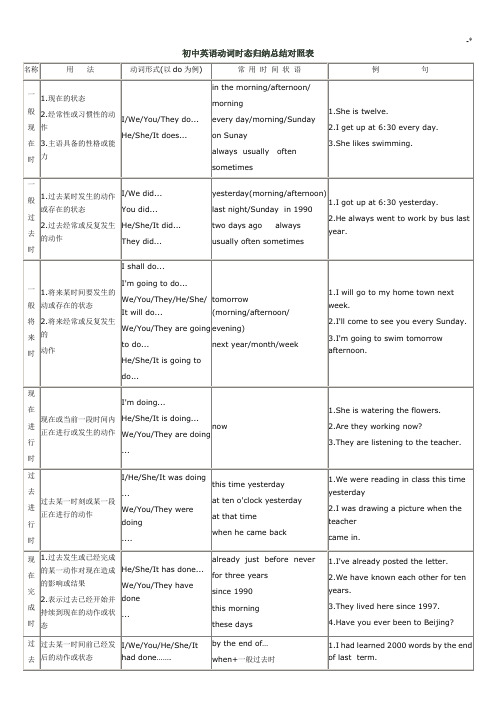
初中英语动词时态归纳总结对照表
初中英语时态专项练习
1、一般现在时。
通常用“usually, often, every day, sometimes”。
一般现在时基本用法介绍
一、一般现在时的功能
1.表示事物或人物的特征、状态。如:The sky is blue.天空是蓝色的。
2.表示经常性或习惯性的动作。如:I get up at six every day.我每天六点起床。
3.表示客观现实。如:The earth goes around the sun.地球绕着太阳转。
二、一般现在时的构成:
肯定句:
1).主语+系动词 be(is, am, are )+名词(形容词,介词短语)
2) .其他主语+动词原形+其它
第三人称单数+动词-s+其它
如:I am a boy.我是一个男孩。We study English.我们学习英语。Mary likes Chinese.玛丽喜欢汉语。三、一般现在时的变化
否定句:1)主语+ be (is,am,are)+ not +其它。如:He is not a worker.他不是工人。
2)其他主语+do not(don’t)动词原形+其它I don't like bread
第三人称单数+does not(doesn’t)动词原形+其它He doesn't often play.
一般疑问句:1)Be(Is,Are) +主语+其它?如:-Are you a student? -Yes. I am. / No, I'm not.
2)Do其他主语+动词原形+其它?
初中英语动词在各种时态中的变化规则

初中英语动词在各种时态中的变化规则
实义动词在各种时态中的变化规则
⼀、⼀般现在时
当主语为第三⼈称单数时,实义动词变化如下:
1、⼤多数动词在词尾直接加s,如read → reads ,look→ looks,play→ plays
2、以辅⾳字母加y结尾的动词,要先将y变为i,再加es如:fly →flies carry →carries study →studies
3、以“s, x, ch, sh”结尾的,在词尾加“es”,发⾳为[iz] 如:teach-teaches [iz]; watch-watches [iz] box---boxes
4、以“o”结尾的动词,加“es”,读[z] 如:go-goes [z] do-does [z]
5、特殊情况:have -- has
⼆、⼀般过去时
动词过去式分为规则和不规则形式
(1)规则形式的变化规律及读⾳
规则动词的过去式由“动词原形+-ed”构成,具体变化有:
①直接在词尾加-ed。-ed在浊辅⾳和元⾳后⾯读【d】;在清辅⾳后⾯读【t】;在发【t】和【d】⾳的字母后⾯⼀律读【id】如: want—wanted【id】, work—worked【t】, need—needed【id】, clean—cleaned【d】
②以不发⾳的e结尾的在词尾加-d,读⾳同①
如:like—liked【t】, live—lived【d】, move—moved【d】
③以⼀个元⾳字母加⼀个辅⾳字母结尾的重读闭⾳节动词,先双写结尾的辅⾳字母,再加-ed。如:stop—stopped,plan-planned,beg- begged,drop-dropped
初中英语五大时态总结归纳
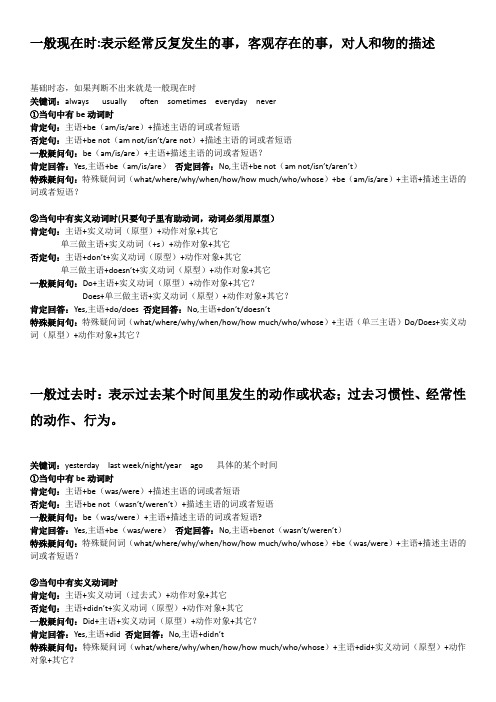
一般现在时:表示经常反复发生的事,客观存在的事,对人和物的描述
基础时态,如果判断不出来就是一般现在时
关键词:always usually often sometimes everyday never
①当句中有be动词时
肯定句:主语+be(am/is/are)+描述主语的词或者短语
否定句:主语+be not(am not/isn’t/are not)+描述主语的词或者短语
一般疑问句:be(am/is/are)+主语+描述主语的词或者短语?
肯定回答:Yes,主语+be(am/is/are)否定回答:No,主语+be not(am not/isn’t/aren’t)
特殊疑问句:特殊疑问词(what/where/why/when/how/how much/who/whose)+be(am/is/are)+主语+描述主语的词或者短语?
②当句中有实义动词时(只要句子里有助动词,动词必须用原型)
肯定句:主语+实义动词(原型)+动作对象+其它
单三做主语+实义动词(+s)+动作对象+其它
否定句:主语+don’t+实义动词(原型)+动作对象+其它
单三做主语+doesn’t+实义动词(原型)+动作对象+其它
一般疑问句:Do+主语+实义动词(原型)+动作对象+其它?
Does+单三做主语+实义动词(原型)+动作对象+其它?
肯定回答:Yes,主语+do/does 否定回答:No,主语+don’t/doesn’t
特殊疑问句:特殊疑问词(what/where/why/when/how/how much/who/whose)+主语(单三主语)Do/Does+实义动词(原型)+动作对象+其它?
初中英语时态讲解(完整版)
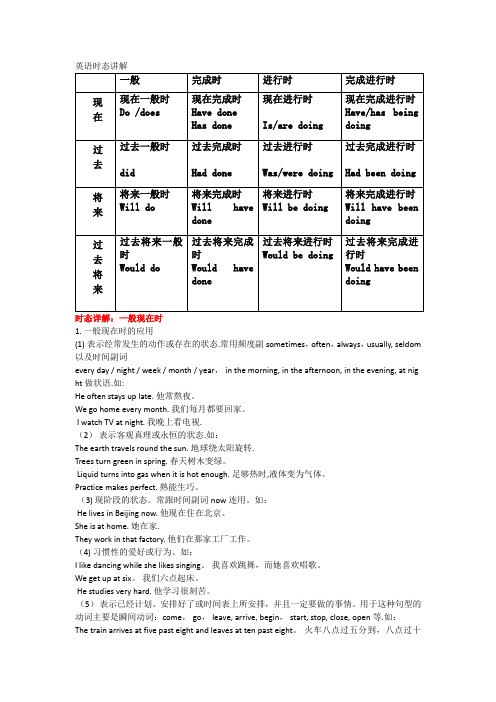
英语时态讲解
1.一般现在时的应用
(1)表示经常发生的动作或存在的状态.常用频度副sometimes,often,always,usually,seldom 以及时间副词
every day/night/week/month/year,in the morning,in the afternoon,in the evening,at nig ht做状语.如:
He often stays up late.他常熬夜。
We go home every month.我们每月都要回家。
I watch TV at night.我晚上看电视.
(2)表示客观真理或永恒的状态.如:
The earth travels round the sun.地球绕太阳旋转.
Trees turn green in spring.春天树木变绿。
Liquid turns into gas when it is hot enough.足够热时,液体变为气体。
Practice makes perfect.熟能生巧。
(3)现阶段的状态。常跟时间副词now连用。如:
He lives in Beijing now.他现在住在北京。
She is at home.她在家.
They work in that factory.他们在那家工厂工作。
(4)习惯性的爱好或行为。如:
I like dancing while she likes singing。我喜欢跳舞,而她喜欢唱歌。
We get up at six。我们六点起床。
He studies very hard.他学习很刻苦。
初中英语语法(动词时态)

需要更完整的资源请到 新世纪 教育网 - www.xsjjyw.com
用法:将来会出现或发生的动作
常用时间状语:this evening, tomorrow, next month, in a few minutes, at the end of this term 动词构成: 1. will/shall+动原 2.am/is/are going to+动词原型 3. am/is/are(about)+动词不定式 4. am/is/are+coming等现在分词 以work为例:will/shall work am/is/are going to work am/is/are(about) to work am/is/are coming/leaving…
需要更完整的资源请到 新世纪 教育网 - www.xsjjyw.com
Examples: It snows in winter. It doesn’t snow in winter. Does it snow in winter?
Βιβλιοθήκη Baidu
需要更完整的资源请到 新世纪 教育网 - www.xsjjyw.com
需要更完整的资源请到 新世纪 教育网 - www.xsjjyw.com
否定构成:will/shall not… am/is/are not… 特殊疑问句举例:What will you do tomorrow? When are we going to have a class meeting?
- 1、下载文档前请自行甄别文档内容的完整性,平台不提供额外的编辑、内容补充、找答案等附加服务。
- 2、"仅部分预览"的文档,不可在线预览部分如存在完整性等问题,可反馈申请退款(可完整预览的文档不适用该条件!)。
- 3、如文档侵犯您的权益,请联系客服反馈,我们会尽快为您处理(人工客服工作时间:9:00-18:30)。
动词的时态(一)
一般现在时
在英语中,不同时间里以不同方式发生的动作或存在的状态,要用不同的动词形式来表示,动词的这种不同形式称为动词的时态。
时态从时间上划分,可分为四大类:现在时;过去时;将来时;过去将来时。从行为上,每一类可以分为四种形式:一般式;进行式;完成式;完成进行式。这样英语的动词合起来,总共有十六种时态,初中只需掌握其中的八种时态。
1、一般现在时
(1)一般现在时表示现在的状态、习惯性的动作或主语所具备的性格和能力等。
① 当动词是be时,第一人称用am,第二人称用is,其他人称用are.
① 当动词是实义动词时,一般用动词原形,但如果主语是第三人称单数时,
助动词后原来的谓语动词要恢复原形。例如:
I like music.I don’t like music.
Do you like music?Yes, I do No, I don’t
(2)一般现在时的用法
① often, usually, every day, sometimes, always 等时间状语连用。如:
He goes to school by bus every day.
They often play football
① 表示能力、职业、特征。如:
Miss Gao teaches English.
Do you speak Japanese?
① 表示客观存在。如:
The earth moves round the sun.
Time and tide wait for no man.
① 表示已经安排好或计划好的事。如
The plane takes off at 7:30.
Classes begin at 8:00
① 在时间状语和条件状语从句中,主句用一般将来时,从句用一般现在时。如:
If I see him, I’ll tell him to give you a call.
We’ll wait until he comes back.
注意:
a. 一般现在时的一些常见的时间状语有:always, often, usually, sometimes, seldom, ever, never, every day, now and then, from time to time
b. 现在进行时有时用来代替一般现在时,表示一个经常性的重复的动作或状态。这时句中常带always, forever以表示说话人的某种感情,如赞叹、厌烦等。如:
He is always thinking of others.
He is always talking big.
动词的时态(二)
一般过去时
(1)一般过去时表示过去某一时间所发生的动作或存在的状态。
① 当动词为be动词时,应该用相应的过去式:
am is ---- was are ---- were
否定形式为:was not ---- wasn’t were not ---- weren’t
疑问句是将was, were 置于主语之前。
I was in Grade Three last term.
I wasn’t in Grade Two last term.
Which grade were you in?
① 当动词为实义动词时,用动词的过去式,过去式的变化有规则和不规则
形式表。
go ---- went begin ---- began sleep ---- slept run ---- ran
I heard the good news just now.
The twins didn’t go to school last week
Did you see the film yesterday ?
(2)一般过去时的用法
① 表示过去某一时间或一段时间发生的动作或存在的状态。常和表示过去的状语连用:yesterday, last week, a minute ago, in 1998, just now, in those days等。例如:
They had a baby last month.
My mother was ill yesterday.
He went out just now.
① 用于since引导的从句,主句的谓语动词如果用现在完成时,since引导的从句一般要用一般过去时。如:
He has worked in the factory since it opened in 1990.
You haven’t changed much since we last met.
注意:
a. 表示过去的时间状语常见的有:yesterday, last night(week, year, month, Sunday), then, at that time, just now, a few days(weeks, months) ago.以及由after, before, when, while引导的的表示过去的时间状语。
b. 一般过去时可以用来表示现在的时间,这主要用于日常会话,使用的语气较为婉转客气。如:
I wanted to ask if I could borrow your bike.
动词的时态(三)
一般将来时过去将来时
(1)一般将来时表示将要发生的动作或存在的状态。常与表示将来的时间状语连用:tomorrow, next week, next month, in a few days, from now on。如I’m going to visit the museum this Sunday.
I’ll be there in half an hour.
We’ll arrive tomorrow.
(2)一般将来时的构成
① be going to + 动词原形。Be随主语人称和数的变化而变化,否定句在be 后面加not, 疑问句是将be放到主语之后。例如:
It’s going to be fine tomorrow.
He isn’t going to speak at the meeting.
What are you going to do next?
① will +动词原形。Will可以和各种人称及数的主语连用。否定句在will后加not,缩写成won’t,疑问句需将will提至主语之前。例如:
We will have a basketball match next week.
Will you come to the party?
I won’t lend it to you.
① shall + 动词原形。此结构常用于主语为第人称I / we的句中,疑问句表示提建议或征求意见。如:
When and where shall we meet ?
Shall I turn on the TV ?
(3)
